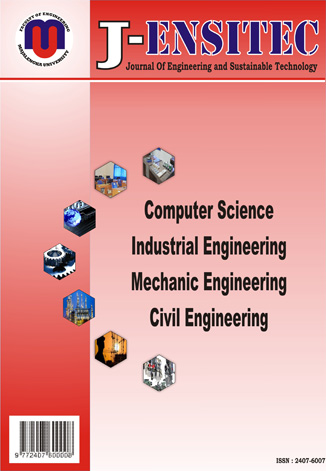PERANCANGAN ALAT PELUBANG PLASTIK KEMASAN TEMPE DENGAN PENDEKATAN ANTHROPOMETRI GUNA MENINGKATKAN PRODUKTIVITAS
DOI:
https://doi.org/10.31949/jensitec.v10i02.9269Abstract
Pak Temmy Rahadi's Tempe UMKM is one of the tempe making UMKM located in Ds. Karangandong, Kec. Kedamean, Gresik. This UMKM was founded in 2010. Mr. Temmy Rahadi's tempe UMKM has a daily tempeh production target of 450 to 600 pcs and uses 80 kg to 100 kg of soybeans for daily production. The majority of customers are market middlemen, penyetan sellers, and home-based people in Kedamean, Gresik. In developing tempe MSMEs, there are various aspects that need to be considered to improve product quality and market competitiveness. One critical aspect is the tempeh packaging process, which plays an important role in ensuring product safety and quality. Currently, Mr. Temmy's tempeh MSMEs are facing significant problems related to the plastic hole punching tool for tempeh packaging which uses a knife in the process before packaging. The tool for punching plastic packaging using a knife requires a long processing time and also the results of the punching are not uniform, resulting in imperfect holes in the plastic packaging, thus making the tempe fermentation process less than optimal. Therefore, researchers are interested in raising this problem. By making a plastic hole punch tool for tempeh packaging, we hope that it will be able to improve the performance of tempeh production. In designing a plastic hole punch tool for tempeh packaging, researchers used ergonomic anthropometric approaches.
Keywords:
Tempe, Plastic Punching Tool for Tempe Packaging, Anthropometrics, ProductivityDownloads
References
S. Wignjosoebroto, ERGONOMI, STUDI GERAK DAN WAKTU, SURABAYA: GUNA WIDYA, 2006.
A. P. Irawan, Perancangan dan Pengembangan Produk Manufaktur, Yogyakarta: Andi, 2017.
Y. Purba, Inovasi Nilai Pelanggan Dalam Perencanaan dan Pengembangan Produk. Aplikasi Strategi Samudra Biru Dalam Meraih Keunggulan, Yogyakarta: Graha Ilmu, 2009.
E. N. S. Y. Aris Setiyani, "NEW PRODUCT DEVELOPMENT (NPD) UNTUK PRODUK HANDWASH," Profisiensi, p. 87, 2015.
E. Nurmianto, Ergonomi : Konsep Dasar dan Aplikasinya, Surabaya: Guna Widya, 2004.
Anisa, "ANALISIS TINGKAT RISIKO ERGONOMI PADA AKTIVITAS MANUAL HANDLING DI PT CEVA LOGISTIK INDONESIA SITE MICHELIN PONDOK UNGU BEKASI TAHUN 2012," Tugas Akhir, Bekasi, 2012.
S. Wignjosoebroto, ERGONOMI STUDI GERAK DAN WAKTU, SURABAYA: GUNA WIDYA, 2006.
E. Nurmianto, Ergonomi : Konsep Dasar dan Aplikasinya, Surabaya: Guna Widya, 2004.
A. P. Irawan, Perancangan dan Pengembangan Produk Manufaktur, Yogyakarta: Andi, 2017.
H. F. Satoto and M. Khotib, "Perancangan Alat Pembentuk Pasak dengan Pendekatan Ergonomi guna Meningkatkan Produktivitas dan Menurunkan Kelelahan Kerja," TEKNIKA, pp. 165-172, 2023.
I. C. Laksamana and H. F. Satoto, "Usulan Perbaikan Fasilitas Kerja pada Produksi Parutan Kelapa Berdasarkan Hasil Evaluasi QEC dan REBA," Senakama:Prosiding Seminar Nasional Karya Ilmiah, pp. 137-162, 2023.
H. F. Satoto and W. Widiasih, "Redesain Kemasan Produk UMKM Jamu Cukai Untuk Meningkatkan Penjualan," Begawan:Jurnal Pengabdian Masyarakat, pp. 36-43, 2021.
Published
How to Cite
Issue
Section
License
Copyright (c) 2024 Abdilah Fajar Khoirulloh, Handy Febri Satoto

This work is licensed under a Creative Commons Attribution-ShareAlike 4.0 International License.
An author who publishes in the J-ENSITEC (Journal of Engineering and Sustainable Technology) agrees to the following terms:
- Author retains the copyright and grants the journal the right of first publication of the work simultaneously licensed under the Creative Commons Attribution-ShareAlike 4.0 License that allows others to share the work with an acknowledgment of the work's authorship and initial publication in this journal
- The author is able to enter into separate, additional contractual arrangements for the non-exclusive distribution of the journal's published version of the work (e.g., post it to an institutional repository or publish it in a book) with the acknowledgment of its initial publication in this journal.
- The author is permitted and encouraged to post his/her work online (e.g., in institutional repositories or on their website) prior to and during the submission process, as it can lead to productive exchanges, as well as earlier and greater citation of the published work







